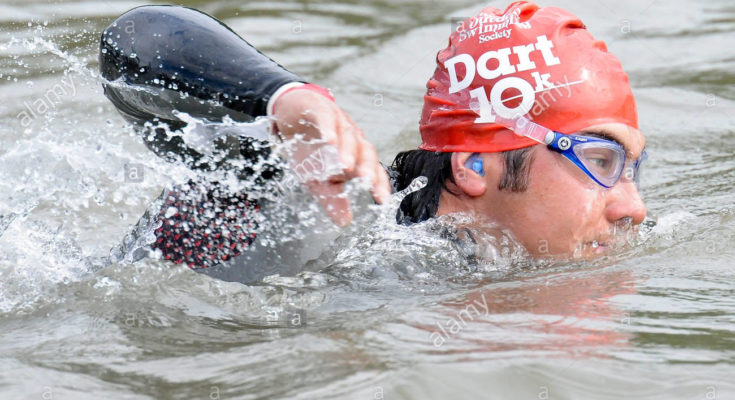When I entered the Dart 10k in 2014 my aim was to finish last. That is to say I wanted to finish – and fully expected to be among the last to do so. I’d taken up open water swimming a couple of years ago for fitness, fun and relaxation after suddenly discovering I could do distance crawl – and I’d spent the previous winter learning how to breath on both sides. I’m a lot closer to my pension than my graduation so I’m not doing this to be a racer or an athlete.
The Dart 10k is the major event organised by the Outdoor Swimming Society and runs from Totnes in Devon half way to Dartmouth. Although on the maps the course appears to be up-stream of the river estuary that runs into the English Channel, in fact the tide sweeps all the way up to Totnes. So the swimmers embark at high tide and hope to get a little help from the ebb of the seawater. But this also means the water you swim in is salty nearly from the start.
I expected a swim of longer than four hours – and it was only as the event got closer that I began to believe I might achieve it in less than four hours.
In the event, I nearly achieved last place – except that two or three people managed to be more leisurely than me.
The Dart organisers call their slowest swimmers the Leisurely Wave – but still expect them to achieve a mile, comfortably, in at least 40 minutes. Before entering the water, I’d already discovered that quite a few ‘leisurely’ swimmers could sustain miles of 35 minutes or better over the distance of six miles. In truth the bulk of the entrants to the swim put themselves down for the leisurely wave, regardless of their capabilities. The question was – how many of us were there in the swim for whom a 40-minute mile was our fastest mile, not our slowest?
This is what I thought the Dart swim would be like and how I planned it before I did it.
- I took a boat trip from Totnes to Dartmouth;
- using the map I broke the course into 500m stretches.
From this I decided
- the first half of the course broke neatly down into 1km stretches separated by bends
- it would be really deep all the way – so reaching my glucose tablets, which I intended to carry, would be hard;
- I could swim keeping both banks equidistant;
- I could easily find the channels of water with the fastest flow;
- or I could take a course on the left bank of the river, where most of the deep channels are;
- the support from the current and the tide would be about 1km per hour;
- I could work out when the faster “waves” of swimmers would overtake me;
- the reed bed about 1km from Totnes would be fun and soothing;
- the tree “cathedral” of deep forested banks, just after the first pontoon, would be awe-inspiring;
- the merger of two rivers just before Stoke Gabriel would be a bubble bath;
- navigating this crossing would be tricky – but could be done by treating the right bank of the Dart as a distant island;
- the big lagoon after that point would be a nightmare;
- the second pontoon – in the big lagoon – would be hard to find;
- the final stretch around the Dittisham headland would prove hard.
Of the assumptions in this list, just two bore a semblance to reality. A few of my misconceptions worked to my advantage; most didn’t.
Take the bends first of all. Here’s some lessons I learnt about river swimming, from the Dart and a couple of earlier expeditions on the Trent:
- Don’t plan to mark the course by counting the bends;
- when you think you’re round a bend, you’re probably only half way round;
- in your imagination you may sweep majestically round the bends; in practice you’ll spend all your time changing direction to avoid hitting the bank;
- if you are hitting the bank, you may well be on a bend;
- if you can see a bend coming up, you are about half a mile from it.
Maybe there are swimmers who sweep round bends and then power along single 1km straits. Most swimmers, I suspect, were able to complete the course by stringing along behind others in a long line. If you’re being Leisurely, you find there’s nobody in front of you and nobody behind you. You are on your own.
Sooner or later the other yellow wavers found their pace – and maybe just half a dozen of us were left making a leisurely pace. Dodging trees was now just half the challenge. Personally, I was confronting the problem of having tried to do the swim with a new swim hat and an official swim hat – also new – rammed on top of it. My temples were hurting – and it made me feel cold and sick. Follow the advice: don’t bring new equipment (although what you do about the official swim hat I’m unsure. Can we have it a week beforehand next time? Get it the day before and sleep in it?)
At about 1km the public path on the left came to an end and I stopped and gave a thumbs up to my supporters. They didn’t see me do this – or so they said. I checked my watch and so far as I could see I was doing fine.
The Reed Bed
I had looked forward to the reed bed, which comes next. Most of it is protected by a low wall. After about 500m there’s an inlet in the bed (which the tour guide earlier in the year said is an ecological disaster) and if you’re hugging the bank you have to make sure you don’t swim into it. Actually, if you were being truly leisurely you would swim a little bit into the inlet and have a look round.
That’s what I said then. Now I think I should book into a swimming pool and see if I can do a mile in 40 minutes.
I enjoyed those long, sometimes leisurely weekend swims over the summer and could have enjoyed the Dart with the right headwear.
It’s a mystery why all but a handful of swimmers complete the course in less than four hours. Geographically I swam almost exactly 10k. Based on my time, I swam the equivalent of 8k, just as the training manual says. Over that distance I’d expect to average 2k an hour.
The entry requirement says you should be able to complete a mile in 40 minutes and then swim on. It seems that most entrants maintain quite a steady pace. That would mean most of the yellow, leisurely wave would complete within 3hrs 20 minutes (or 200 minutes).
But why should that be the case? In preparation this was a typical set of times for me (yes I did take preparation seriously.):
Mile 1: 40 minutes
Mile 2: 44 minutes
Mile 3: 50 minutes
Mile 4: 54 minutes
Mile 5 (which I never got round to completing): 56-60 minutes?
That’s an expected time of 4hrs 8 minutes. I completed in 4 hrs 15 minutes after at least one lengthy break. Just three people finished after me. Just six people out of 700 took longer than four hours.
Finally what was the effect of the tide on a four hour, 10k swim? This altitude graph from my GPS gives a clue.




